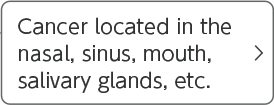About consultation and reservation
Q1.
If I don’t have a referral letter, can I have a consultation?Open+A1.
In principle, a referral letter and other medical information are required. The referral letter should be written by your primary doctor who is the most familiar with your condition. In addition, making a reservation for a consultation is necessary.
→ For details, please refer to "Flow from consultation to treatment".
Q2.
If I haven’t made a reservation, can I have a consultation?Open+A2.
Reservations are required in principle.
→ For details, please refer to "Flow from consultation to treatment".
Q3.
What should I do to have a consultation?Open+A3.
Please consult your doctor if you wish to receive heavy ion therapy. And then, you need to ask to prepare medical information such as referral letters to HIMAK.
The medical information includes a "Referral letter", "(CT/MRI/RI/PET-CT) CD-R which shows chronological change and those reports", "Blood test results which show the transition of the tumor marker", "Blood test results which show recent results of urea nitrogen and creatinine", "Pathological findings", "Respiratory function test results", etc.
You must have a reservation and no walk-ins accepted. If you have any questions, please contact us from the website.
→ For details, please refer to "Flow from consultation to treatment".
About heavy ion therapy
Q1.
Can anyone undergo heavy ion therapy?Open+A1.
Heavy ion therapy is not applicable in the following cases.
- Cancer which has metastasized to three or more parts in the body.
- Blood cancer such as leukemia, cancer that has spread throughout the body.
- Diseases of organs accompanied by peristalsis, such as gastric cancer and colon cancer.
- Cancers for which better alternative treatment method has already been established.Q2.
Are all types of cancers applicable for heavy ion therapy?Open+A2.
Not all cancers are applicable for heavy ion therapy. We treat the following cancers:
- Unresectable bone and soft tissue tumors (tumors that occur in bone, muscle, blood vessels, subcutaneous tissue, etc.)
- Localized prostate cancer
- Some head and neck cancers
- Lung and mediastinal tumor
- Tumors of the digestive system
- Hepatobiliary and pancreatic tumors
- Tumors of the urinary system
- Mammary gland / Gynecological tumors
- Metastatic tumors (3 or less in the lung)
- Metastatic tumors (3 or less in the liver)
- Metastatic tumors (3 or less in lymph nodes)
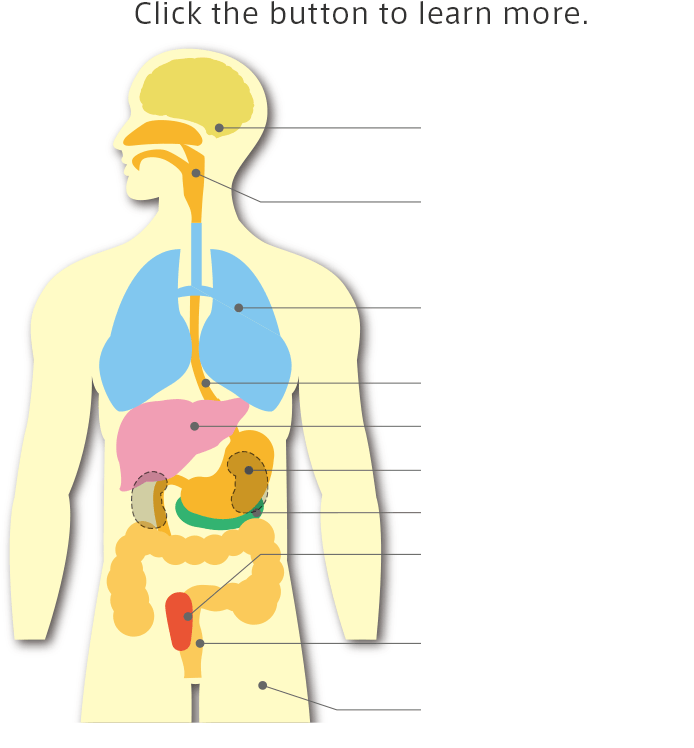
 Skull base tumors(number of treatment times: 16 times)
Skull base tumors(number of treatment times: 16 times)What are skull base tumors?
The tumors that occur in the deepest part of the extracranial-intracranial area, and in the center of the head, are collectively called the skull base tumor. These tumors occurring in the deepest parts are often next to or adhere to many important nerves and major blood vessels. Therefore, surgery is difficult. Among the skull base tumors, there are radioresistance tumors.
Clinical conditions and requirements for heavy ion therapy
- ■In cases where surgery is impossible or the tumor cannot be completely removed by surgery.
- ■Primary skull base tumors (e.g. chordoma, chondrosarcoma) without lymph node metastasis and distant metastasis.
- ■Skull base tumor which is located upper than the second cervical vertebra.
- ■The tumor can be measured by CT and MRI.
Points of attention regarding heavy ion therapy
The beam direction is carefully selected so as to avoid the optic nerve and the brain stem as much as possible because skull base is where important nerves and organs are gathered closely.
Expected side effects
There is difference about the toxicities depend on each tumor location where is closed to the critical organs such as the brain, optic nerve or jawbone, so the possibilities of these toxicities will be explained at the consultation.
 Head and neck cancers(numbers of treatment times: 16 times)
Head and neck cancers(numbers of treatment times: 16 times)What are head and neck cancers?
The head and neck are deemed as being the parts below the brain and above the clavicle, including the eyes, nose, mouth, ears and throat. It is said that about 5% of all cancers occur in the head and neck because head and neck contains many morphologically complex and important organs, and it is necessary to treat the cancer of each part in consideration to their characteristics.
Head and neck cancers are classified into the following; oral cancer, pharyngeal cancer, laryngeal cancer, paranasal sinus and nasal cavity cancer, salivary gland cancer, and thyroid cancer. Current treatment targets of heavy ion therapy are non-squamous cell carcinoma and lacrimal adenocarcinoma, head and neck mucosal malignant melanoma, and inoperable squamous cell carcinoma of the ear and nasal sinuses. Radiation therapy has the advantage of preserving function and form in the treatment of head and neck cancer. Heavy ion therapy also allows for localized irradiation of lesions, which may not only improve treatment outcome, but may also reduce the late effects of treatment. In addition, heavy ion therapy is said to be highly effective for cancerous types that are resistant to conventional radiation and chemotherapy.
The actual method of treatment depends on the location of the tumor, its pathological diagnosis, and its’ degree of progression. In some cases, a multidisciplinary treatment, which is a combination of surgery, radiation therapy and chemotherapy, may also be performed.
Clinical conditions and requirements for heavy ion therapy
- ■Head and neck non-squamous cell carcinoma or lacrimal gland tumor which is diagnosed histologically, inoperative head and neck mucosal malignant melanoma and choroidal malignant melanoma, and inoperative primary squamous cell carcinoma of the ear and nasal sinuses.
- ■In cases where there is no metastasis to other organs or lymph nodes, and all the lesions can be within one irradiation field. (N0M0 case, or N1M0 case in which lesions are within one irradiation field.)
- ■There is a measurable tumor on CT or MRI.
- ■Inoperable tumor, recurrence or residual tumor after surgery.
Points of attention regarding heavy ion therapy
Side effects depend on the site of the lesion and progress. Our doctor will explain in detail at the time of consultation.
Expected side effects
During treatment, adverse events may occur mainly in normal tissue such as skin, mucous membranes. (e.g. oral and pharyngeal mucositis, dermatitis, salivation disorder, otitis media, etc.) It is necessary to do the local observation for 2 to 4 weeks after treatment.
In addition, there is a risk of side effects such as optic neuritis, osteomyelitis, osteonecrosis, and muscle fibrosis depending on the treatment lesion. Those may occur 3 months or more after heavy ion therapy.
There is difference about the toxicities depend on each tumor location where is closed to the critical organs such as the brain, optic nerve or jawbone, so the possibilities of these toxicities will be explained at the consultation.
 Localized lung cancer(approximate number of treatment times: 1 to 16 times)
Localized lung cancer(approximate number of treatment times: 1 to 16 times)What is lung cancer?
Lung cancer is cancerous cells of the bronchial and alveolar cells.
As it progresses, cancer cells proliferate, destroying surrounding tissue, and spread through the bloodstream and the lymphatic system. Lung cancer is likely to spread to lymph nodes, brain, liver, adrenals, and bones.There are several types of lung cancer, depending on the form of the cancer cells. In the case of stage I non-small cell lung cancer that is localized in the lung, treatment by heavy ion therapy can be completed in about 1 week of outpatient visits.
Clinical conditions and requirements for heavy ion therapy
- ■Non-small cell lung cancer diagnosed by histology or cytology.
- ■Inoperable, or when the patient does not want surgery.
- ■Clinical stage I and cT2b-T3N0M0 (TNM classification 8th edition).
Points of attention regarding heavy ion therapy
In order to perform irradiation more precisely, there are cases when the position may be confirmed by in-room CT.
As with treatment of other areas, please keep in mind that smoking cessation is required during and after treatment.Expected side effects
Adverse events may occur mainly in skin, chest wall / ribs, lung / bronchus, esophagus. (e.g. dermatitis, pneumonia, esophagitis, etc.)
 Locally advanced non-small cell lung cancer(number of treatment times: 16 times)
Locally advanced non-small cell lung cancer(number of treatment times: 16 times)What is lung cancer?
Lung cancer is cancerous cells of the bronchial and alveolar cells. As it progresses, cancer cells proliferate, destroying surrounding tissue, and spread through the bloodstream and the lymphatic system. Lung cancer is likely to spread to lymph nodes, brain, liver, adrenals, and bones.
There are several types of lung cancer, depending on the form of the cancer cells. For locally advanced non-small cell lung cancer, treatment by heavy ion therapy can be completed on an outpatient basis in approximately 4 weeks.
Clinical conditions and requirements for heavy ion therapy
- ■Non-small cell lung cancer (Clinical stage II-III).
- ■There is no invasion into the heart, large blood vessels, trachea, esophagus.
- ■Chemotherapy can not be performed due to age or other reasons, or chemotherapy is refused by the patient.
Points of attention regarding heavy ion therapy
In order to perform irradiation more precisely, there are cases when the position may be confirmed by In-Room CT.
As with treatment of other areas, please keep in mind that smoking cessation is required during and after treatment.Expected side effects
Adverse events may occur mainly in skin, chest wall / ribs, lung / bronchus, esophagus. (e.g. dermatitis, pneumonia, esophagitis, etc.)
 Esophageal cancer(approximate number of treatment times: 12 times)
Esophageal cancer(approximate number of treatment times: 12 times)What is esophageal cancer?
Esophageal cancer is a malignant tumor that originates in the mucous membrane of the esophagus, and there are two main types - squamous cell carcinoma and adenocarcinoma. Squamous cell carcinoma originates from the epithelium on the surface of the lining of the esophagus. On the other hand, adenocarcinoma often occurs in the background of reflux esophagitis caused by gastric acid refluxing in the esophagus, accounting for more than half of esophageal cancer in the West. In Japan, over 90% of esophageal cancer is squamous cell carcinoma.
Heavy ion therapy can reduce side effects on the important organs such as the spinal cord, lungs and heart while maintaining the therapeutic effect on esophageal cancer.
Clinical conditions and requirements for heavy ion therapy
- ■Inoperable or surgical refusal cases (Stage I).
Points of attention regarding heavy ion therapy
It is necessary for the patient to avoid drinking alcohol for a certain period after heavy ion therapy.
The patient may be requested to attach a clip in the esophagus in order to allow the heavy ion beam to be administered with a higher precision.Expected side effects
Dermatitis and esophagitis are side effects during treatment. In particular, radiation esophagitis can occur to a greater or lesser extent.
Side effects after treatment may include esophageal ulcers, esophageal strictures, esophageal perforations, radiation pneumonitis, cardiac dysfunction, and the like.
 Liver cancer(approximate number of treatment times: 2 to 4 times)
Liver cancer(approximate number of treatment times: 2 to 4 times)What is liver cancer?
Liver cancer is roughly classified into “primary liver cancer” which occurs in the liver, and “metastatic liver cancer” which metastasized from another organ.
"Primary liver cancer" includes "hepatocellular carcinoma" in which the cells of the liver become cancer, and "cholangiocarcinoma" in which the cells of the duct which drains bile into the duodenum (bile duct) become cancer. In Japan, “hepatocellular carcinoma” accounts for 90% of “primary liver cancer”.Most liver cancer (hepatocellular carcinoma) is due to chronic hepatitis and cirrhosis caused by hepatitis virus (type B and C) infection. Heavy ion therapy is a treatment that is highly effective because it irradiates cancer intensively so its damage to the normal liver is small. Therefore, the deterioration of liver function is difficult to occur. Because of long-standing hepatitis and liver cirrhosis, the liver itself is predisposed to develop cancer. Consequently, it may cause new cancer at other sites, and it is necessary to follow up after treatment by a specialist.
Clinical conditions and requirements for heavy ion therapy
- ■Diagnosed histologically or clinically as hepatocellular carcinoma (HCC) or intrahepatic cholangiocarcinoma.
- ■Hepatic function is maintained to some extent. (Child-Pugh classification is A or B)
- ■There is no metastasis to other organs, and it is a focal lesion (with a diameter of 12 cm or less).
- ■There is no digestive tract near the tumor.
- ■Untreated, or one month or more has passed since the previous treatment for the treatment target lesion, and the residual or recurrence has been confirmed on the image.
Points of attention regarding heavy ion therapy
In order to perform irradiation more precisely, gold marker of several millimeters may be inserted into the liver. The use of gold markers will be decided after consultation with our doctor, your primary doctor, and the doctor of the relevant medical institution.
Expected side effects
Adverse events may occur in the skin / subcutaneous tissue, ribs, gastrointestinal tract, liver function. (e.g. dermatitis, gastrointestinal bleeding, rib fracture, etc.)
 Renal cancer(approximate number of treatment times: 12 times)
Renal cancer(approximate number of treatment times: 12 times)What is renal cancer?
Among the cancers appearing in the kidney, renal cell carcinoma is the one whose cells in the kidney parenchyma have become cancerous and malignant. Even if the cancer appears in the same kidney, cancerous cells in the renal pelvis are called "renal pelvis cancer" and are distinguished from renal cell carcinoma. Renal cell carcinoma and renal pelvis carcinoma differ in the nature of their cancers, and respective methods of treatment. Generally, "renal cancer" refers to renal cell cancer.
Clinical conditions and requirements for heavy ion therapy
- ■Diagnosed histologically or clinically as renal cell carcinoma.
- ■Renal function on the healthy side should be maintained to some extent.
- ■There is no metastasis to other organs, and it has a focal lesion.
- ■There is no digestive tract near the tumor.
Points of attention regarding heavy ion therapy
In order to perform irradiation more precisely, gold marker of several millimeters may be inserted into the kidney.
In similar reason, there are cases when the position may be confirmed by In-Room CT.
Expected side effects
Adverse reactions may appear on the skin and abdominal wall, gastrointestinal tract, liver function, pancreas, and kidney. Blood toxicity, loss of appetite, gastrointestinal ulcer / bleeding, hematuria and intratumoral infection are predicted as adverse events.
 Pancreatic cancer(approximate number of treatment times: 12 times)
Pancreatic cancer(approximate number of treatment times: 12 times)What is pancreatic cancer?
More than 90% of cancers that occur in the pancreas can be in the cells of the pancreatic duct. This is called pancreatic duct cancer, and pancreatic cancer usually refers to this pancreatic duct cancer.
In the case of heavy ion therapy for locally advanced pancreatic cancer, chemotherapy using Gemcitabine or TS-1 is generally used in combination.Clinical conditions and requirements for heavy ion therapy
- ■Invasive pancreatic ductal carcinoma of the clinical stage I, IIA, IIB, III (The 8th edition of the UICC TNM Classification) which has been diagnosed by histopathology or images. (Note 1)
- ■Judged inoperable for reasons such as, being in a particular stage or complications.
- ■The functions of the main organs remain maintained.
- ■The tumor is not close to the digestive tract.
- ■There is no gastroduodenal ulcer (except for ulcer scars).
- ■There is no metal stent placement in the bile ducts. (If required, replace it with a plastic stent.)
- Note 1: It is desirable that the cancer have been histopathologically diagnosed.
Points of attention regarding heavy ion therapy
In order to perform irradiation more precisely, markers of several millimeters may be inserted into the pancreas. The use of gold markers will be decided after consultation with our doctor, your primary doctor, and the doctor of the relevant medical institution.
Expected side effects
Adverse reactions may appear on the skin and abdominal wall, gastrointestinal tract, liver function, pancreas, and biliary tract. Blood toxicity, loss of appetite, gastric ulcer/bleeding, intratumoral infection and stenosis of bile duct are predicted as adverse events.
 Locally advanced cervical cancer(approximate number of treatment times: 20 times)
Locally advanced cervical cancer(approximate number of treatment times: 20 times)What is cervical cancer?
The majority of gynecological cancers are uterine cancers which include cervical cancer and uterine body cancer. Uterine body cancer, also known as endometrial cancer, originates from the endometrium inside the endometrial area that raise the fetus. On the other hand, cervical cancer originates from the cervix at the entrance of the uterus. As it often occurs near the entrance of the uterus, it can be said that cervical cancer is easy to be observed and inspected through an ordinary gynecological examination. It is relatively easy to treat and has a good prognosis if it is detected early, but will be difficult if progressed.
Clinical conditions and requirements for heavy ion therapy
- ■Histologically diagnosed with adenocarcinoma or adenosquamous cell carcinoma or squamous cell carcinoma.
- ■FIGO clinical stage IIA-IIIB.
- ■In the case of squamous cell carcinoma, the tumor diameter is 6cm or more. (Note 1)
- ■There is no lymph node enlargement of more than 1cm in diameter in the abdominal para-aortic region when observed by an abdominal CT.
- ■No medical history of surgery or chemotherapy.
- Note 1: There is no lower limit for tumor size in adenocarcinoma or adenosquamous cell carcinoma.
Points of attention regarding heavy ion therapy
In order to perform irradiation more precisely, patients may be asked to control defecation and urination.
Expected side effects
Mainly appear in the organs in the irradiated area, which are the bladder, urethra, and rectum. Side effects include frequent urination, hematuria, and melena.
 Prostate cancer(approximate number of treatment times: 12 times)
Prostate cancer(approximate number of treatment times: 12 times)What is prostate cancer?
Prostate cancer is caused by cells in the prostate losing normal cell proliferative function and proliferating randomly. Prostate cancer can often be treated successfully if it is discovered early. Usually prostate cancer grows relatively slowly. It often metastasizes to nearby lymph nodes and bones, but may metastasize to the lungs, liver, etc.
Clinical conditions and requirements for heavy ion therapy
- ■T1c-T3N0M0 (no organ metastasis, no lymph node metastasis). Or primary prostate cancer of T4 (bladder neck invasion) N0M0.
- ■The Gleason Score is clear by histopathological examination.
- ■The PSA test prior to prostate biopsy is clear.
- ■Prostate cancer is classified into low, middle and high risk groups depending on the condition of the lesion. In the case of middle and high-risk groups, it is required to combine treatment with hormonal therapy.
Points of attention regarding heavy ion therapy
In order to perform irradiation more precisely, gold markers of several millimeters may be inserted into the prostate. The use of gold markers will be decided after consultation with our doctor, your primary doctor, and the doctor of the relevant medical institution.
In the intermediate-risk group, heavy ion therapy is given after 0 to 6 months of hormone therapy. In the high-risk group, heavy ion therapy will be given after 6 months of hormone therapy, in addition, hormone therapy will be continued for 1 and a half years after heavy ion therapy. Hormone therapy be performed by your primary doctor's instructions.
Expected side effects
Mainly appear in the organs in the irradiated area, which are the bladder, urethra, and rectum. Side effects include frequent urination, hematuria, and melena.
 Rectal cancer (pelvic recurrence)(approximate number of treatment times: 16 times)
Rectal cancer (pelvic recurrence)(approximate number of treatment times: 16 times)What is rectal cancer?
Colorectal cancer occurs in the large intestine which is about 2m in length and made up of the cecal, colon and rectum. And the study shows that the Japanese are prone to cancer in the sigmoid colon and rectum.
Colorectal cancer originates from the cells of the colonic mucosa. One type is a part of a benign polyp which is called adenoma and becomes cancerous, and the other develops directly from normal mucosa. It develops from the surface of the mucous membrane and invades the wall of the large intestine gradually and metastasizes to other organs such as lymph nodes, the liver and lungs as it progresses.Clinical conditions and requirements for heavy ion therapy
- ■Recurrent lesions which localize in the pelvis that is histologically or clinically diagnosed after primary colorectal cancer resection.
- ■No obvious recurrent lesion outside the pelvis.
- ■Cases where a curative resection for recurring lesions is not applicable or the patient does not want to have surgery.
- ■Main organ function is maintained.
- ■The tumor is not close to the digestive tract.
- ■It is not an anastomotic recurrence.
- ■There are no open wounds or active and intractable infections in the irradiation area.
Points of attention regarding heavy ion therapy
In order to perform irradiation more precisely, there are cases when the position may be confirmed by in-room CT.
If the tumor is close to the digestive tract, an absorbable spacer may be inserted. The spacer insertion will be decided after consultation with our doctor, your primary doctor, and the doctor of the relevant medical institution.Expected side effects
Adverse reactions mainly occur in skin, urinary tract, nerve, bone, digestive tract, etc. which is contained in the treatment area. Intractable ulcer and bleeding may appear in the tissue near the tumor.
 Bone and soft tissue tumors(approximate number of treatment times: 16 times)
Bone and soft tissue tumors(approximate number of treatment times: 16 times)What are bone and soft tissue tumors?
Bone and soft tissue tumors are a general term for bone tumors, which generated from bones, and soft tissue tumors, which generated from soft tissues such as muscles, fats, nerves and blood vessels, etc.
Primary malignant bone and soft tissue tumors are also referred to as "bone and soft tissue sarcomas" . As the typical disease names, chordoma, osteosarcoma and liposarcoma are given.
Sarcomas occur in various parts of the body, including the limbs, torso, head and neck, and in the retroperitoneum.
Clinical conditions and requirements for heavy ion therapy
- ■Histologically diagnosed primary malignant bone and soft tissue tumor (Note 1) or, its tumor equivalent (Note 2).
- ■N0M0 case.
- ■The tumor can be measured.
- ■Non-adaptation of radical resection. (Cases judged by specialists to be radically inoperable, or if the patient refuses a resection.)
- ■Pretreatment-postoperative recurrence is treatable. Chemotherapy patients should have a 2-week interval before the start of heavy ion therapy.
- ■There are no metal fixtures affecting treatment planning (dose planning) in the irradiation area.
- Note 1: Non-epithelial malignancy arising from bones, joints and soft tissues all over the body, e.g. osteosarcoma, chondrosarcoma, MFH, MPNST, synovial sarcoma, liposarcoma, leiomyosarcoma, etc.
- Note 2: E.g. chordoma, recurrent osteoblasts, desmoid etc.
Points of attention regarding heavy ion therapy
If there are metal fixtures in the irradiation area, some or all of them may be removed so as not to affect treatment planning (dose planning).
If the tumor is close to the digestive tract, an absorbable spacer may be inserted. The spacer insertion will be decided after consultation with our doctor, your primary doctor, and the doctor of the relevant medical institution.
Expected side effects
Adverse reactions mainly occur in normal tissue (skin, nerves, bones, etc.) contained in the treatment area, and in organs (e.g. digestive tract) near the tumor.
 Lymph node metastasis(approximate number of treatment times: 12 times)
Lymph node metastasis(approximate number of treatment times: 12 times)What are lymph node metastasis?
Lymph node metastasis of gastrointestinal cancer, lung cancer, esophageal cancer, gynecologic cancer, and so on.
Clinical conditions and requirements for heavy ion therapy
- ■Less than 3 lymph node metastases from gastrointestinal cancer, lung cancer, esophageal cancer or gynecologic cancer. The metastases of the lymph nodes include deep cervical lymph node, thoracic lymph node, abdominal lymph node, and pelvic lymph node. The lymph node metastases which should be contained in one irradiation field.
- ■Surgery and radiation therapy are performed on the primary site, and there is no recurrence or residual lesion.
- ■There is no other metastasis.
Points of attention regarding heavy ion therapy
In order to perform irradiation more precisely, there are cases when the position may be confirmed by in-room CT.
If the tumor is close to the digestive tract, a spacer may be inserted. The spacer insertion will be decided after consultation with our doctor, your primary doctor, and the doctor of the relevant medical institution.Expected side effects
Adverse reactions mainly occur in normal tissue (skin, nerves, bones, etc.) contained in the treatment area, and in organs (e.g. digestive tract) near the tumor.
■Approximate number of fractions and period for treatment
Types of
cancerNumber of
fractionsTreatment
periodSkull base cancer 16 4 weeks Head and Neck cancer 16 4 weeks Lung cancer 1〜4 Within 1 week Esophageal Cancer 12 3 weeks Liver cancer 2〜4 Within 1 week Kidney cancer (Renal cancer) 12 3 weeks Pancreatic cancer 12 3 weeks Uterine cancer 20 5 weeks Prostate cancer 12 3 weeks Local recurrence of rectal cancer 16 4 weeks Bone & soft tissue cancer 16 4 weeks Lymph node metastasis 12 3 weeks Some of the information listed above is based on clinical trials. In addition, the cancer that can be treated depends on the facility. Please contact the treatment facility for more details.
→ For details, please refer to "Cancers suitable for heavy ion therapy".
Q3.
Can I receive treatment for lung cancer even with emphysema?Open+A3.
Heavy ion therapy reduces the radiation lose at normal tissue and can focus on cancer, so even if patients have emphysema, there is a lower risk of respiratory function to be decreased. However, depending on the condition of emphysema, treatment may not be recommended.
→ For details, please refer to "Features of heavy ion therapy".
Q4.
Can I receive heavy ion therapy even if I have a pacemaker?Open+A4.
It can be treated for abdominal or pelvic lesion.
However, it is difficult to treat for the chest.
If you have a pacemaker implanted, please bring your pacemaker patient notebook on your initial visit to our center.
Please feel free to contact us, if you have any questions or concerns.Q5.
Can breast cancer be treated?Open+A5.
Basically, surgery is the first choice for breast cancer treatment.Q6.
I previously underwent radiation therapy. Can I receive heavy ion therapy?Open+A6.
In case radiotherapy was performed in the past, it is difficult to perform heavy ion therapy for the same lesion. Our doctors and the tumor board review of our center will carefully judge the applicability of heavy ion therapy in this case.Q7.
If a cancer has metastasized, can it be treated by heavy ion therapy?Open+A7.
Even if the cancer has metastasized, it may be treated by heavy ion therapy if which fall under any of the following:
・ In case that there are only lung metastasis (3 or less)
・ In case that there are only liver metastasis (3 or less)
・ In case that there are only lymph node metastasis
However, heavy ion therapy is not possible if there are multiple metastatic lesions (for example, if there are lung and liver metastases). It is necessary to give priority to systemic treatment.Q8.
Are treatments different between for children and for adults?Open+A8.
The way of treatment itself does not differ between children and adults.Q9.
Is there an age restriction to receive treatment?Open+A9.
Basically, it is from the age of 12 and there is no upper limit, but there is a condition that patients must remain motionless for about 30 to 60 minutes on the treatment table.Q10.
What is the difference between X-ray therapy and heavy ion therapy?Open+A10.
They are both a type of radiation therapy, but "radiation dose concentration" and "biological effect (= ability to kill cancer)" are different.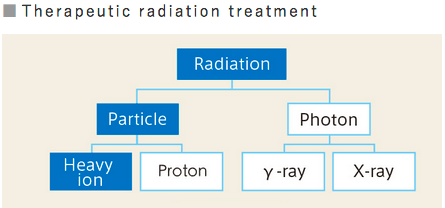
"Radiation dose concentration"
With conventional radiation therapy such as X-ray and γ-ray, a large radiation dose is inevitably deposited near the surface of the body and diminish in strength thereafter. Deep-seated tumors does not receive sufficient damage and healthy tissue is also irradiated. On the other hand, heavy ion therapy can pin-point accurate radiation according to Bragg Peak, and deliver sufficient damage to target cancer while minimizing damage to healthy tissue. Heavy ion and proton beams have characteristic called "Bragg Peak" which enables high dose to be administered to the tumor while limiting dose to the surface of the patient's body. Heavy ion therapy can also be expected to be effective in deep-seated tumors.
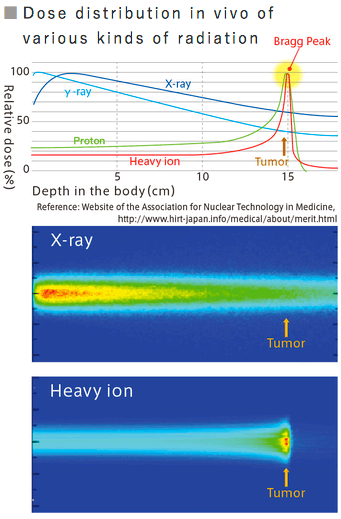
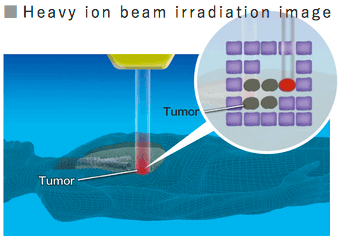
"Biological effect (= ability to kill cancer)"
Radiation, which is used to treat cancer, damages the DNA of cancer cells at the molecular level, prevents cell division and leads to the death of the cancer. Heavy ion beam has particularly a strong effect as heavy ion beam is heavier particles accelerated at high speeds and shows strong biological effects (= ability to kill cancer) when they hit cancer cells. Heavy ion’s biological effect (= ability to kill cancer) is superior so there is a characteristic that it is highly likely to be effective against cancers that are resistant to ordinary radiation treatment.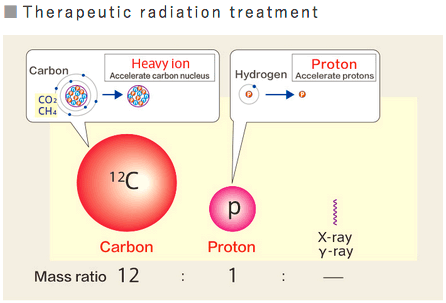
→ For details, please refer to "Features of heavy ion therapy".
Q11.
Will I need to be hospitalized during treatment?Open+A11.
Heavy ion therapy is a treatment with less burden on the body, so patients receive heavy ion therapy on an outpatient basis. However, depending on the treatment plan and illness, there are cases that during the treatment period patients are required to be hospitalized at a medical institution nearby while receiving heavy ion therapy.Q12.
Approximately how long does one treatment session take?Open+A12.
The time to actually irradiate the tumor with the heavy ion beam is about 5 to 20 minutes, but the time from entering the treatment room to leaving the room is about 15 to 120 minutes, including changing clothes and positioning before irradiation. In the case of respiratory-gating treatment such as lung cancer, liver cancer, bone and soft tissue tumors and some pancreatic cancers, it takes a little longer.Q13.
How long does the treatment period take?Open+A13.
The period of treatment varies for each type of cancer. In heavy ion therapy, it is possible to concentrate radiation with a high lethal effect on cancer, so it is possible to increase the amount of radiation per dose and reduce the number of treatment sessions required. The number of treatments is from 1 to 20 times (1 day to 1 month) in our center.
→ For details, please refer to "Approximate number of fractions and period for treatment".
Q14.
Does the patient feel pain and/or heat during heavy ion therapy?Open+A14.
The irradiation itself causes no pain or heat.Q15.
Does the heavy ion therapy cause hair loss?Open+A15.
Radiation affects only the irradiated area. Therefore, if radiation passes through an area with hair during head or neck cancer treatment, there may be temporary hair loss in that area only. Heavy ion therapy irradiates only the necessary amount to a limited area that includes the cancer, so there are considerably fewer side effects compared with general radiation therapy. However, it cannot be said that there are no side effects at all. Symptoms of side effects differ depending on the treatment lesion, radiation direction and radiation dose. In addition, even with similar treatment plans, there are individual differences in the appearance of side effects, so at the time of informed consent before deciding on heavy ion therapy, our doctor and nurse will explain the expected side effects. Also, they will explain what to do if the side effects occur.Q16.
If there are no side effects of treatment, does it mean that is there no treatment effect?Open+A16.
The treatment effect and the extent of side effects are not always proportional. Just because there are no side effects, you shouldn’t think the treatment is not working well. Even for cancers of the same lesion, the irradiation range and treatment plan are different for each patient, and it is not necessary to compare with other patients at all because there are individual differences as to when, where and what kind of side effects appear.Q17.
Could I stop treatment before completion?Open+A17.
When treatment is stopped halfway, cancer cells recover from the damage done by heavy ion therapy, greatly decreasing the treatment’s effect. Before starting treatment, please let your doctor know in advance if there is potentially any interval when you cannot visit our center during the treatment period.Q18.
Is it possible to smoke or drink during treatment?Open+A18.
It is said that if you continue smoking during treatment, side effects will increase and the treatment effect will decrease for head & neck cancer and lung cancer. Because side effects may be strengthened when treating other cancer also, we recommend that you stop smoking. In regards to drinking alcohol, because alcohol exacerbates tumor's and normal tissue's edema by the treatment, please do not drink alcohol.Q19.
Can I take a bath during treatment?Open+A19.
You can take a bath as usual during treatment. Since the skin at the irradiation part will be inflamed and the condition is like light sunburn, it is sensitive to stimulation. Staying in the bath for a long time or rubbing the part may cause irritation, so please be careful when bathing. Also, we recommend that you not go to hot springs, saunas, stone spas and swimming pools during or immediately after treatment. Please enjoy after the inflammation of the irradiated area has faded.Q20.
Can I get the flu vaccination?Open+A20.
Patients who wish to get the flu vaccine, please consult our doctor beforehand.Q21.
Will the cancer disappear after heavy ion therapy?Open+A21.
Depending on the type of cancer, cancers damaged by heavy ion therapy gradually shrink over time. Although the effectiveness of treatment might be recognized during treatment, it usually takes some time before the treatment effect is obtained. Therefore, after heavy ion therapy, we follow-up regularly in cooperation with the patient's primary doctor.Q22.
How do you evaluate the effect of treatment?Open+A22.
The way of evaluating the treatment is using methods such as CT / MRI / PET-CT, diagnostic findings, blood test (tumor marker), and improvement of the subjective symptoms of the patient. Since the response to treatment cannot be judged by only one examination, follow-up observation every 1 to 6 months after treatment will be performed by the doctor of our center.
Others
Q1.
Is there a parking lot in the facility?Open+A1.
There is a parking lot in our center. However, due to the limited number of spaces, please use the nearby parking lot when our parking lot is full.Q2.
Are there shops and ATMs in the facility?Open+A2.
There are vending machines for drinks in our center, but there are no convenience stores, ATMs, coffee shops, etc.Q3.
Is accommodation nearby?Open+A3.
There is accommodation near our facility.
However, we do not arrange accommodation, so please make reservations by yourself.Q4.
Can I borrow a wheelchair?Open+A4.
If you need a wheelchair when you come to our center, please make a request at the reception. Also, when you return the wheelchair, please let the receptionist know.
(*Please note that wheelchairs are limited in number.)


